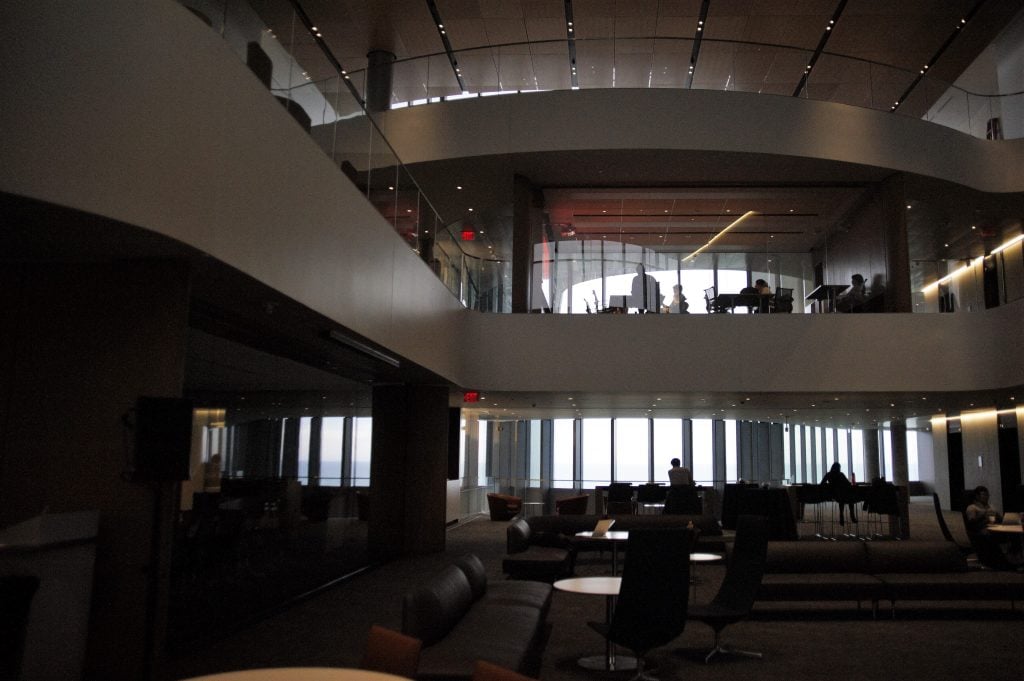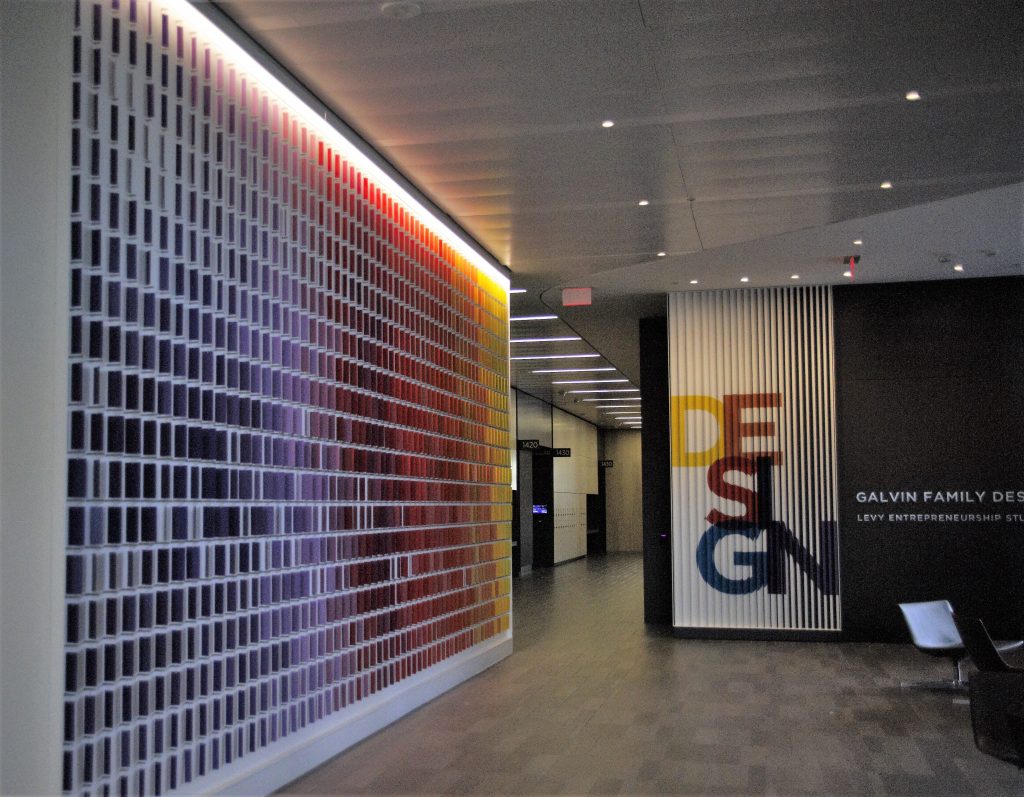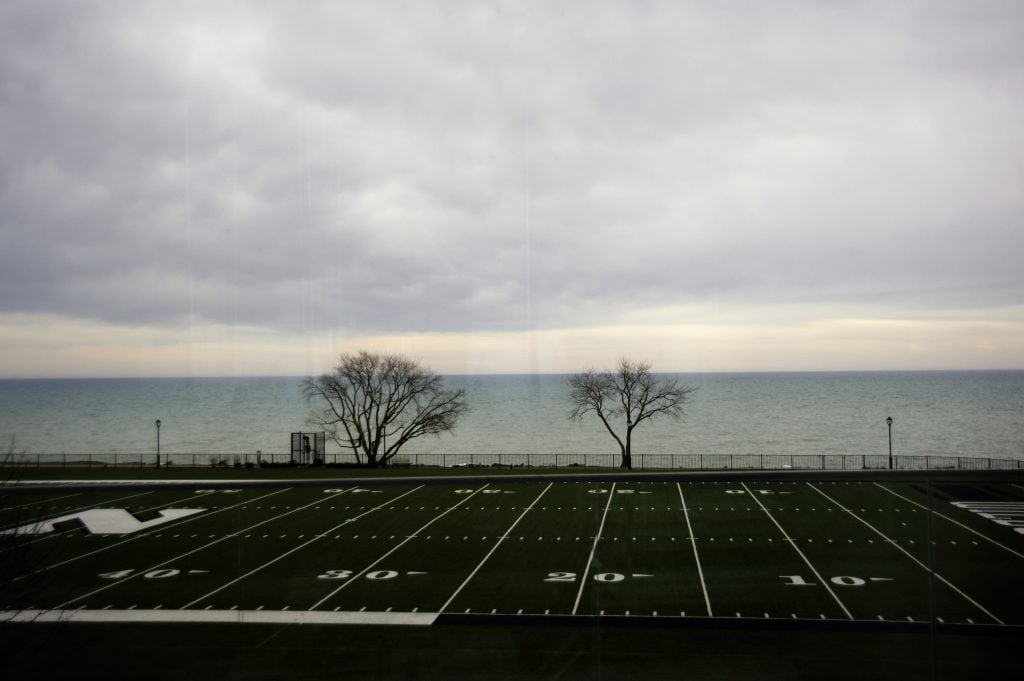Building Strikes More Than One Delicate Balance
Extending out from Collaboration Plaza to form the rest of the Global Hub are four distinct wings—neighborhoods if you will—where the quieter, more reflective business of serious scholarship can take place. Part of the beauty and triumph of the Global Hub is the balance it manages to strike between spaces that are “excessively public” and drive brave collaboration and places that provide the serenity that many need to do their best work. “I think there really is a balance—and we have found an amazing balance here in this building,” said Harry Kraemer, a Kellogg alumnus, trustee and strategy professor, as part of the “Why Space Matters” discussion.
“Another thing the architects had a very deft hand with was warming up large spaces,” explains Leann Paul, an architect and consultant who since 2010 has helped manage the construction project on behalf of Kellogg. This was achieved in part through the incorporation of lots of wood, but also through the building’s design. Its four quadrants all meet in the center, which is actually two stacked atriums, she continues. The lower atrium—Collaboration Plaza—connects the lower level, first and second floors. Above that is a second atrium connecting all the quadrants for the faculty floors. Called the “Faculty Summit,” this upper atrium provides a second crossroads within the building, occasioning the same types of collaboration-fostering intersections and interactions between faculty members that Collaboration Plaza does below.

Four of the five firms in the original architectural competition proposed plans centered around a single five- to six-story atrium, according to Paul. “That can be beautiful, but Kellogg’s culture of closeness was very important—and at certain times of the year we don’t have enough people in the building to populate a really large space like that and make it feel active,” she explains. “So the solution that KPMG came up with to split those atriums and stack them was brilliant—resulting in a building that felt much more to a scale and that really made sense to us.”
Careful attention to acoustics also helped get the sound levels just right. “Sound is really important in a building like this,” Paul says. “Classrooms are very protected from sound in all directions, as are faculty offices—but in communal spaces it’s really an art, because if it’s too quiet, it’s wrong and if it’s too loud or lively, it’s wrong,” she continued. “We think right now this space hits it pretty well.”
Four Wings Extend Out from Central Plaza Like Neighborhoods
One wing, the Galvin Family Design Wing, is home to four unique design studios—creative workspaces where students can meet to explore innovative ideas. In one, an artists-in-residence space, a high table and stools surrounded by easels are ready to welcome artists, designers and architects. “The dean feels very strongly about teaching people with other types of approaches—so teaching through art, through design,” explains Paul. “She feels that the process you go through for design projects brings a lot of value to business education.” The artists-in-residence space was set up to allow creative types to come in and work one on one with students. Another of the design studios is a collaborative space designed to host companies in residence. A third technology room is tricked out with a large touch screen, teleconference technology, scanners and other gizmos to equip students to interact seamlessly on tech ventures. And a fourth is a “maker’s space,” complete with a 3-D printer, foam core, white boards and unlimited Post-Its, where students can develop prototypes.

The design wing also houses a traditional tiered classroom and two adjacent 70-seat, flat classrooms divided by a partition, which can be removed to create an even larger space for hosting conferences. The Kellogg Innovation and Entrepreneurship Initiative takes up the area at the end of the wing, providing space where students can meet with faculty members or mentors on individual projects. “We are really excited about getting those people near the students,” says Paul. “They were all in Jacobs, but it was more of a trek to come together.”
Another wing houses the Market, a restaurant and 325-seat dining space where students can eat three meals a day and enjoy lake views and the warmth of a central fireplace as they gather with classmates. Above the Market on the second floor is the two-story White Family Auditorium, which features retractable seating that can accommodate between 200 and 300 people depending on how it is configured. A full central kitchen serves both, so all the food for the building comes in and out behind the scenes.
Outside the auditorium, beneath a practice football field, is a geothermal system that helps heat and cool the building efficiently. A series of 146 double rolled tubes built into the ground are filled with liquid, and because the Earth’s core temperature remains constant at around 50 degrees, this liquid requires less warming in the winter and less cooling in the summer to regular the building’s temperature. Serving as the first source of heating and cooling, the system is adequate on all but very high-load days, when the building taps into the university’s heating and cooling system. “It’s an efficient way to do things, although unfortunately you get no LEED credit,” says Paul. LEED, or Leadership in Energy and Environmental Design, is a popular green building certification program used worldwide. The design team did consider photovoltaics and wind—both of which would have contributed to LEED certification—but the technology wasn’t there to do it for a building of this size. “This is more proven and has been around a lot longer,” says Paul. But even without wind or solar features, the building is solidly within LEED certification, she says.










